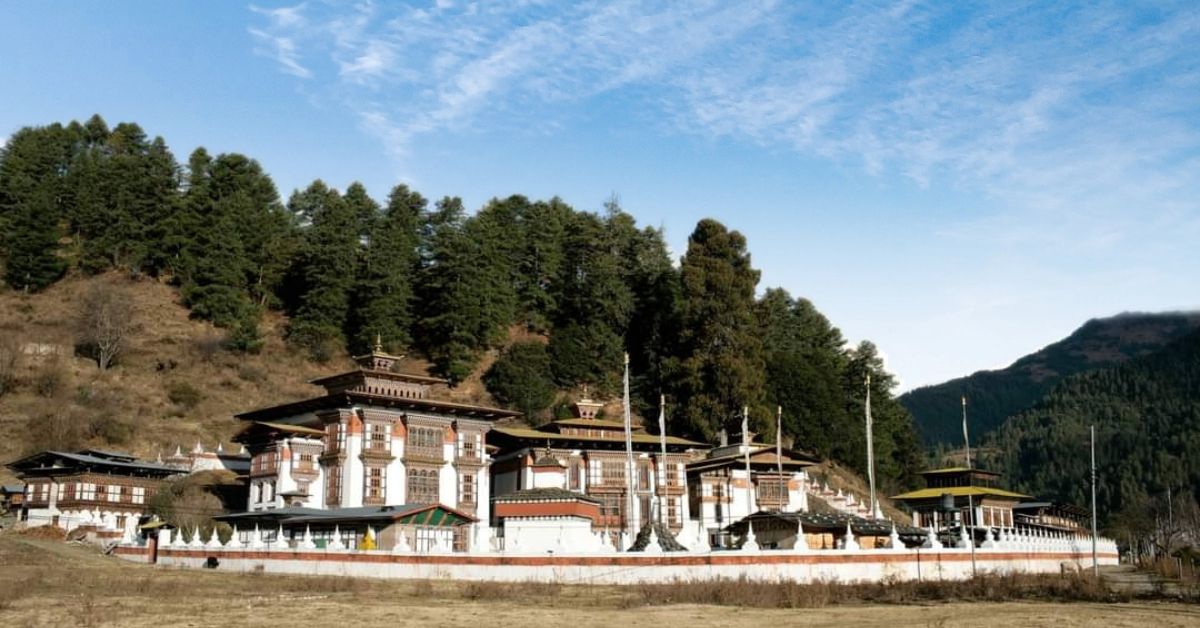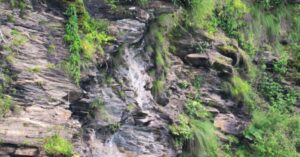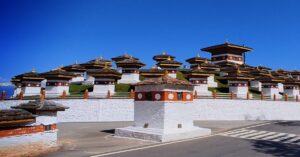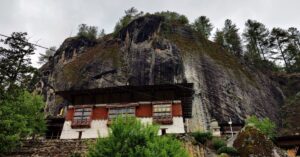Kurjey Lhakhang is the first sacred site of Guru Rinpoche in Bhutan, blessed in the 8th century. Kurje is the “impression” left by Guru Rinpoche’s holy body on the rock in the cave of the Diamond Piled Red Rock (Drakmar Dorje Tsekpa) while meditating to subdue Shelging Karpo, who took the life force (sog) of King Sindhu Raja of Bumthang.
Kurjey Lhakhang is located in Kurje village under Chhoekhor gewog of Bumthang Dzongkhag at an elevation of 2,648 meters. It is the first sacred site of Guru Rimpoche where he subdued evil spirits and wrathful local deities. He then turned the Wheel of Vajrayana Buddhism for the very first time in Bhutan by preaching the Nying-gi Thigpa, the essence of all religions known as the Dzogpa Chenpo Selwai Melong (The Clear Mirror of Great Mahasanti).
Bumthang Kurjey Lhakhang is one of the two sacred places blessed by Guru Rinpoche during his first visit to Bhutan.
How to Reach Kurjey Lhakhang
The Kurjey is located at the Drakmar Dorje Tsekpa (the Vajra Piled Red Cave), around five kilometers north of Chamkhar town, on the right bank of Chamkhar chhu opposite Kenchogsum Lhakhang. It takes only 15 minutes by car to reach Kurjey. If you visit from Chakhar Lhakhang, Kurjey is 2.5 kilometers away. The Kurje Lhakhang is only 1 kilometer from Jambay Lhakhang.
Sacred Relics to See at Bumthang Kurje
- Cave of the Red Cliff (Drakmar Dorje Tsekpa), where Guru Rinpoche meditated;
- Self-arisen body imprint of Guru Rinpoche;
- Guru Lhakhang, Sampa Lhundrup Lhakhang, and Ka Gong Phur Sum Lhakhang;
- The figure of a snow lion with a Garuda (Jachung);
- A cypress tree grown from the Guru’s walking stick;
- Kurjey Drupchhu.
Also Read: Guru Rinpoche in Bhutan: His Visits to Bhutan and Sacred Sites
Historical Significance of Kurje
Kurjey is one of the most sacred sites in Bhutan, regarded as the first holy place established in Bumthang by Guru Rinpoche. The history and importance of Kurjey Lhakhang date back to the year of the Iron Tiger in 810 AD.
According to oral history, King Sindhu Raja of Bumthang had a conflict with a king to the south, known as Naochhe, or ‘Big Nose’. Before sending his warriors, including his son Taklamebar, into battle against Naochhe, Sindhu Raja prayed to local deities for protection, specifically for his son’s safety.
However, the conflict claimed the life of Sindhu Raja’s son, which made Sindhu angry with the local deities. Sindhu then infuriated Shelging Karpo, the main local protector, by ordering his warriors to demolish places of worship. Shelging Karpo thus aimed to kill Sindhu Raja by stealing his soul. As a result, Sindhu Raja slowly became ill and could not be healed by any astrologers. One of Sindhu Raja’s ministers requested the king to invite Guru Rinpoche as a final effort.
At the invitation of King Sindhu Raja of Bumthang, Guru Rinpoche traveled from Nepal and entered Bhutan via Nabji Korphu in the Trongsa Dzongkhag. Guru Rinpoche came to Bhutan to recover the life force (sog) of Sindhu Raja snatched by the local deity, Shelging Karpo, as Guru Rinpoche’s supernatural powers were well known throughout the Himalayan region.
The Meditation to Subdue Shelging Karpo
Once he arrived in Bumthang, Guru Padmasambhava meditated in the cave of the Red Cliff for three months and left his kur (body) jey (print) on the rock cave. Therefore, the cave is considered sacred and is known as Kurje, now surrounded by Kurje Lhakhang.
While Guru stayed in deep contemplation, Khandro did the household chores and helped out with the rituals. Guru pierced the Vajra Piled Red Cave, which hit the palace of the Naga King and shook it.
Lui Gyalpo Pemachen, knowing it was Guru Rinpoche’s work, humbly responded, asking what service he should offer. To this, Guru said, “I need Chhu Drowa Drenpa, an elixir that would liberate all sentient beings”. The Naga king did not understand what it meant and asked what it was.
Guru said, “It is the mixture of 9 different glasses of water”. The Naga king understood and replied that he would offer it.
Then, on the morning of the 7th day after this, Guru told Khandro: “Today we will exhibit the miracle of our achievement. Lhachig Bumden, you take the golden container Gahta and go in the direction of north-west, where there is a small crag. From there, holy water will come out. Before it touches the ground, hold the container and receive it.”
As Khandro arrived there, as destiny would have it, the holy water gushed out and Khandro received it in her container instantly, five Dakinis appeared, and each Dakini held the same container.
Also Read: Drupchhu or Holy Spring Waters in Bhutan: Beliefs and Benefits
The Subjugation of Shelging Karpo
While the princess was away, Guru Rinpoche transformed into his eight manifestations, and they all started to dance in the field. Every local deity appeared to watch this spectacle, but the stony-faced Shelging Karpo stayed hidden away in his rocky hideout.
When Khandro arrived at Marthang, the first ray of the sun hit the Gahta and reflected on the cliff, which then reflected on Khandro. The whole area was filled with rays and rainbows, attracting the attention of evil spirits and demons and taking them by surprise. Shelging Karpo too got tempted by the event and turned himself into a lion peeped from his shelter to watch the show. At that instant, Guru turned into a garuda (Jachhung), pounced upon the lion, and ferociously announced, “Now you, Shelging Karpo, are in the claws of the Great Chant Master, Guru Pema Jungney. You are the one who has seized the life force of King Sindhu Raja”.
Shelging Karpo pleaded. But due to the power of the Guru’s intense prayer, the cave of Shelging Karpo too got sealed, and the footprints of the Guru appeared clearly. All those demons and demigods gathered there witnessed this event and remained awestruck, looking at each other, not knowing whether it was a dream or real. At that moment, Guru and Khandro rushed to Chagkhar Gyalpo Sindhu Raja’s bed carrying the holy water and the king’s life force. Guru opened the skin and the king inhaled his breath, the spider dissolved from the King’s crown, and after drinking the holy water (drowa Drenpai Chhu), the king got alright.
Importance of Kurjey Lhakhang
Kunkhyen Longchen Rabjam said, “On the cliff of the northern mountain, nearby it (Tharpaling). There is the self-arisen body-imprint of the Pema Gyalpo (Guru Rinpoche). Even if you see that just for a single time, the doors to lower rebirths will be closed, and one will tread on the liberation path.”
The grasses that grow in the meadows of Kurjey are believed to bear the self-arisen mantra syllables.
Lama Drukpa Kunley said, “There is no place where I can relieve myself. All the grasses of Kurje bear self-arisen syllable AH”.
Kurjey Lhakhang is the first sacred site of Guru Rinpoche in Bumthang, where he subdued Shelging Karpo and left his body imprint on the cave wall. This event is believed to have taken place in the 8th century when King Sendha Raja invited Guru Rinpoche to cure him of his illness. Guru Rinpoche discovered that the evil actions of Shelging Karpo and other local deities caused the king’s illness. He then meditated for three months inside the cave, subdued the deities, and left his body imprint, giving the site its name, Kurjey, which means “body imprint”.
Kurjey Lhakhang is important as it was built where Guru Rinpoche meditated, subdued the local deity, treated King Sindhu Raja, and left his body impression to benefit all sentient beings.
The Bumthang Kurjey is also the final resting place of the remains of the first three Kings of Bhutan.
Description of Kurjey Lhakhang Complex
Kurjey Lhakhang is built against a cave where Guru Rinpoche subdued the deity, Shelging Karpo, and imprinted his body on the cave. The Lhakhang is a three-story structure composed of stone masonry, mud plaster, and timber. It is nestled on the rocky side of the hill, surrounded by 108 Chortens.
Below the Kurjey cave, one can see a lion figure with a Garuda (Jachung) above it. It is said to represent the struggle between Guru Rinpoche (transformed into a garuda) and Shelging Karpo (transformed into a snow lion). Above the Lhakhang, the tall cypress tree can be seen, which is believed to have sprouted from the Chakhar (walking stick) of Guru Rimpoche. In front of the Lhakhang, there is a small crawl-through rock passage that is believed to cleanse the sins if one can make it through. A five-minute walk up the hillside near the entrance is the holy water created by Guru Rinpoche. This sacred water is known as Kurjey Drupchhu.
The complex has three structures, namely Guru Lhakhang, Sampa Lhundrup Lhakhang, and Ka Goen Phur Sum Lhakhang. The structure is as magnificent as the dzong, with nyimchu rabsel projected out from the third floor. It has a whitewashed wall with dedicated wood carvings and fine paintings. The main Lhakhang is built against the cave where the Guru left the imprint on the third floor. The ground floor is currently used as a residence for monks and storage. The trace of gedkars is still visible on the front facade of the Lhakhang, which was closed during the renovation.
Guru Lhakhang
According to the history of Kurjey Lhakhang, Guru Lhakhang is the oldest temple built by Sindhu Raja in the 8th century after he devoted himself to Buddhism. However, the Guru Lhakhang was rebuilt by Chogyal Minjur Tempa in 1652 while he was the first Trongsa Penlop. The lhakhang was later renovated by Trongsa Penlop Ugyen Phuntsho in the 19th century. The Shelging Karpo Neykhang was added to the main structure in 2008.
At the entrance to the lower floor of Sangay Lhakhang is a small rock passage where it’s believed that those who can crawl through it will cleanse all their sins. Sangay Lhakhang houses the Buddhas of the three times. Behind the statues is a passageway believed to have once led to Tharpaling.
The upper floor is the Lhakhang complex’s main and holiest sanctuary. The main statue is Guru Rinpoche, flanked by his eight manifestations and the eight Chortens. Hidden behind the statue of Guru Rinpoche is the meditation cave where he left his body imprint. There are also thousands of small statues of Guru Rinpoche.
Sampa Lhundrup Lhakhang
Sampa Lhundrup Lhakhang (Complete Fulfillment of one’s Mind and Thoughts or Anabhog bhavana) was built in 1900 by Gongsa Ugyen Wangchuck when he was the 12th Trongsa Penlop. The entrance has paintings of the Guardians of the Four Directions and various local deities. Shelging Karpo is represented as a white ghost-like figure riding on a white horse above the doorway to the right. The main relic is a 32-foot-tall or 10-meter-tall statue of Guru Rinpoche, flanked by the statues of the eight manifestations of Guru.
Ka-Gong-Phur-Sum Lhakhang
Ka-Gong-Phur-Sum Lhakhang was built by Ashi Kesang Choden Wangchuck in 1984 under the guidance of Dilgo Khyentse Rinpoche. The Ka Gon Phur Sum Lhakhang means “Three Mystic Revelations of The Eight Pronouncements (Kagye), Abhipraya Samaja (Gongdue), and Vajra Kilaya (Phurpa).”
The Construction of Ka-Gong-Phur-Sum Lhakhang
The construction of Ka-Gong-Phur-Sum Lhakhang on the sacred ground of Kurjey was undertaken by Mayum Chonying Wangmo Dorji and Her Majesty The Queen Mother in keeping with His Majesty’s desire and wishes to build a holy image of Palchen Heruka.
When His Holiness Dilgo Khyentse Rinpoche was consulted, he advised Her Majesty The Queen Mother to build a temple of Ka-Gong-Phur-Sum (Kagye, Gongdue, and Phurpa) in this sacred place. Thus, the construction of this magnificent temple started in 1984.
Description of Ka-Gong-Phur-Sum Lhakhang
Ka-Gong-Phur-Sum Lhakhang has three stories with the main statue of Palchen Chemchog Heruka in wrathful form or the short form “Mahasri Heruka of Palchen Duepa”, with his mystic consort standing imposingly from the first to the third floor. This commanding statue of Palchen Heruka is 34 feet in height and has 21 heads, 42 hands with statues of various deities in each hand, and 8 legs. The mystic consort has 9 heads, 18 hands, 4 legs, and stands 30 feet in height.
First Floor
The 17-foot statue of Drangsong Throepa Lama Gondue, who has three heads, six hands, and four legs, is located to Palchen Heruka’s right. His consort, on the other hand, has one head, two hands, and two legs. A 17-foot statue of Sinbu Throepa Palchen Dorji Phurpa or Vajrakila, with three heads, six hands, and four legs, and his spouse, who has one face, two hands, and two legs, is located on the left side of Palchen Heruka.
Second Floor
The second-floor statues are Phurpa (Vajra Kilaya), Gongdue (Abhipraya Samaja), and Kagye (The Eight Pronouncements). In the Kingdom’s Terma tradition of Buddhism, they are the Chief Tutelary Deities (Yidam).
Top Floor
The life-size statues on the top floor, on the right of Palchen Heruka, are KHEN-LOB-CHOE-SUM or Khenchen Bodhisattva on the right, Guru Rinpoche in the center, and Choegyal Thrisong Deutsan on the left. Statues of similar size on the left side of Palchen Heruka on the top floor are Drogoen Tsangpa Gyare Yeshe Dorji with Zhabdrung Ngawang Namgyel and Gyalse Tenzin Rabgye on the right and left, respectively.
Cypress Tree of Bumthang Kurjey Lhakhang
Kurjey is one of Guru Rinpoche’s three sacred sites, where he planted his walking stick. The other two are the Cypress tree in Baylangdra in Wangdue Dzongkhag and the Cypress tree in Dechen Phodrang Ney in Trashi Yangtse.
The cypress tree at the entrance behind the Lhakhang is believed to have grown from Guru Rinpoche’s walking staff (Chakhar). When Guru Rinpoche subdued Shelging Karpo, the local deity agreed to become a protective deity of Buddhism. Guru Rinpoche planted his walking staff in the ground to seal this agreement. The tree is 1201 years old. Every attempt by the monks to propagate the tree has been futile.
It is believed to have been planted upside down. The tree’s guardian is also believed to have been entrusted to Shelging Karpo – the local deity subdued by Guru Rinpoche. Hence, for anything to do with trees, special permission must be sought from the clay idol of the deity in the sanctum by rolling a pair of dice.
According to the Lam, an incident had happened in the past where red blood oozed out instead of the tree sap when a monk saw the tree branch to be used as ‘Zung’ (inner relics) for a newly built stupa. After this incident, the monk just lived for three years.
Kurjey Tshechu Festival 2025
An annual festival called Kurjey Tshechu is conducted on the 10th day of the 5th month of the Bhutanese calendar. In 2025, it falls on the 5th of July. It commemorates the birth anniversary of Guru Rinpoche, who introduced Buddhism to Bhutan. During the festival, monks perform traditional mask dances. The festival concludes with the unfurling of a giant Guru Thongdroel.
Another festival of Kurje Lhakhang is the Drub ceremony. This annual Kurje Kagay Drubchen is conducted annually on the 4th Bhutanese month in the Ka Goen Phur Sum Lhakhang since 1990. It is funded by Royal Grandmother Ashi Kesang Choeden Wangchuck for the well-being of the kings.
Best Time to Visit Bumthang Kurjey Lhakhang
The Kurjey Lhakhang can be visited throughout the year, but the best time would be in June when the popular Kurjey Tshechu is held. During the Tshechu, a large Thongdrel of Guru Tshengye, the eight manifestations of Guru Rinpoche, is unfurled in the early morning. The Tshechu has a unique and historical mask dance that portrays Guru Rinpoche subduing the local deity Shelging Karpo. One can also choose to attend the annual Kurje Kagay Drubchen, which is conducted on the 4th Bhutanese month, corresponding to April or May.
You can contact Kurjey Lhakhang’s site manager, Sonam Dhendup, at 17535974. You can visit major pilgrimage sites of Bumthang with the Bhutan Pilgrimage Package.
Frequently Asked Questions
Who built Kurjey Lhakhang?
Kurjey Lhakhang was built in three stages by different high-ranking government officials and royals:
- Guru Lhakhang: The oldest temple was built in 1652 by Minjur Tenpa, the Trongsa Penlop.
- Sampa Lhundrup Lhakhang: The second temple was built in 1900 by Ugyen Wangchuck, the first King of Bhutan.
- Ka Gon Phur Sum Lhakhang: The third temple was built in 1990 by Queen Ashi Kesang Wangchuck.
Why was Kurjey Lhakhang built?
Kurjey Lhakhang was built to honor Guru Rinpoche, who subdued the local deity, Shelging Karpo, in the 8th century.
Who discovered Kurjey Lhakhang?
Kurjey was founded by Guru Rinpoche in the 8th century. Kurjey Lhakhang was built by Sindhu Raja. However, the Lhakhang was rebuilt by Chogyal Minjur Tempa in 1652.
Enjoyed reading this blog?




